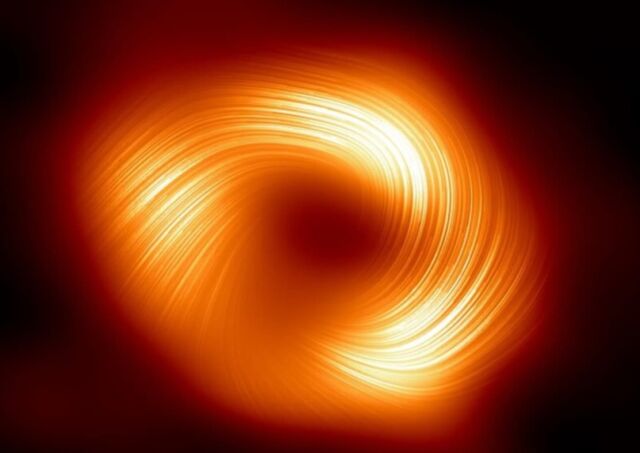 EHT Collaboration
EHT Collaboration
A stunning new image of the Milky Way‘s black hole revealed strong magnetic fields spiraling at its edge.
A new snapshot from the Event Horizon Telescope (EHT) has unveiled, previously unseen, magnetic fields swirling out from the border of the supermassive black hole Sagittarius A (Sgr A).
For the first time, the heart of the Milky Way galaxy was observed through polarized light, unveiling a magnetic field pattern remarkably similar to the one around the black hole in the center of the M87 galaxy. This finding suggests that potent magnetic fields might be typical for all black holes.
Back in 2022, scientists revealed the inaugural image of Sgr A at press briefings globally, including at the European Southern Observatory (ESO). Despite Sgr A being over a thousand times smaller and less hefty than M87, the first-ever imaged black hole, the observations showed striking similarities between the two.
This led scientists to speculate whether they might share common characteristics beyond their appearance. To delve deeper, the team opted to investigate Sgr A in polarized light. Previous examinations of M87 revealed that its magnetic fields enabled it to eject potent jets of material into its surroundings. Building on this groundwork, the latest images have suggested that Sgr A might behave similarly.
Sara Issaoun, NASA Hubble Fellowship Program Einstein Fellow at the Center for Astrophysics, Harvard & Smithsonian, US, and co-lead of the project, said:
“What we’re seeing now is that there are strong, twisted, and organised magnetic fields near the black hole at the centre of the Milky Way galaxy. Along with Sgr A having a strikingly similar polarisation structure to that seen in the much larger and more powerful M87 black hole, we’ve learned that strong and ordered magnetic fields are critical to how black holes interact with the gas and matter around them.”
Harvard Black Hole Initiative Fellow and project co-lead Angelo Ricarte, said:
“By imaging polarised light from hot glowing gas near black holes, we are directly inferring the structure and strength of the magnetic fields that thread the flow of gas and matter that the black hole feeds on and ejects. Polarised light teaches us a lot more about the astrophysics, the properties of the gas, and mechanisms that take place as a black hole feeds.”
These findings were shared in The Astrophysical Journal Letters.
source ESO





Leave A Comment